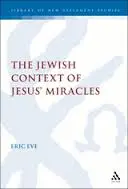

The Jewish Context of Jesus' Miracles
in Library of New Testament Studies
Pages
282
Publisher
T&T Clark
Published
8/1/2002
ISBN-13
9781841273150
Scholarly literature on Jesus has often attempted to relate his miracles to their Jewish context, but that context has not been surveyed in its own right. The present study supplies that lack by examining both the ideas on miracle in Second Temple literature (including Josephus, Philo, the Dead Sea Scrolls, Apocrypha and Pseudepigrapha) and the evidence for contemporary Jewish miracle workers. The penultimate chapter explores insights from cultural anthropology to round out the picture obtained from the literary evidence, and the study concludes that Jesus is distinctive as a miracle-worker in his Jewish context while nevertheless fitting into it.
Reviews
Journal for the Study of the New Testament Supplement Series 231 Sheffield: Sheffield Academic Press, 2002. Pp. 420. Hardcove. $125.00. ISBN 1841273155. Douglas W. Geyer Evanston, IL 60201 The author has written a clear and detailed book, nicely restricted in focus given the boundless domains �Jesus� and �Jewish context. � It reviews major literary themes from Second Temple Judaism as found in texts ranging from Josephus to Qumran fragments. Themes of miracle concern wondrous events caused by God, semidivine agents, or human agents. The book�s synthesis presents specific kinds of evidence to demonstrate how Gospel reports of the miracles of Jesus are congruent with Jewish traditions contemporary to them. The work directly addresses observations set forth by W. Kahl (New Testament Miracle Stories in Their Religious-Historical Setting), that the only two figures from the Gospel period consistently portrayed as �Bearers of Numinous Power� were Jesus and Apollonius of Tyana. Kahl�s view parallels Jesus most closely with non-Jewish sources; Moses, the prophets, and indeed all known Jewish precedents are essentially different in kind from Jesus. The author also addresses observations set forth by G. Vermes, P. W. Barnett, and R. Gray, that a hypothesized class of Palestinian holy men or first-century prophets formed the group of which Jesus was a member. He expertly unhinges the latticework modern scholars have built up around figures such as Honi, Hanina Ben Dosa, Theudas, the Egyptian, the Samaritan under Pilate, or the Imposter under Festus. Even so, the book concludes that the precedent for the miracle-working Jesus is indeed that of the prophet as depicted, broadly and consistently, in a variety of Jewish traditions. Simultaneously, the author yet notes that there is no Jewish tradition, not even about the prophets, that exactly parallels Jesus in terms of the sheer number of healings and exorcisms attributed to him. Chapters 2�8 review miracle and exorcism stories in Second Temple literature, correlating these reports to what is found in the Gospels. Chapter 2 is dedicated to Josephus, chapter 3 to Philo.
[Full Review]
